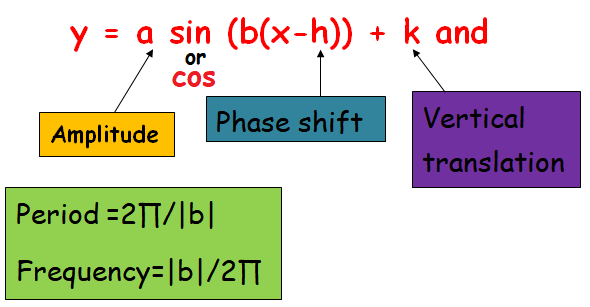AMPLITUDE PERIOD PHASE SHIFT AND VERTICAL SHIFT OF SINUSOID FUNCTION
Subscribe to our ▶️ YouTube channel 🔴 for the latest videos, updates, and tips.
A function is a sinusoid if it can be written in the form
f (x) = a sin (bx+c)+d
where a, b, c, and d are constants and neither a nor b is 0.

Example 1 :
State the amplitude and period of the sinusoid, and (relative to the basic function) the phase shift and vertical translation
y = -2 sin (x - π/4) + 1
Solution :
Amplitude = 2
Period = 2π/|b| ==> 2π/|1| ==> 2π
Frequency = 1/2π
Phase shift = π/4 (π/4 units to the right)
Vertical shift = 1 (Move one unit to up)
In front of the given function, we have negative. So we should do reflection.
So, every sin curve will fit into the interval 0 to 2π.
Example 2 :
Graph the following function
y = 5 cos (3x - π/6) + 0.5
Solution :
Amplitude = 5
Period = 2π/|b| ==> 2π/|3| ==> 2π/3
Frequency = 3/2π
Phase shift = π/6 (π/6 units to the right)
Vertical shift = 0.5 (Move 0.5 unit to up)
So, every cosine curve will fit into the interval 0 to 2π/3.
Example 3 :
Graph the following function
y = -3.5 sin (2x - π/2) - 1
Solution :
Amplitude = 3.5
Period = 2π/|b| ==> 2π/|2| ==> π
Frequency = 1/π
Phase shift = π/2 (π/2 units to the right)
Vertical shift = 1 (Move 1 unit to down)
So, every sin curve will fit into the interval 0 to π.
Example 4 :
Graph the following function
y = 3 cos (x + 3) - 2
Solution :
Amplitude = 3
Period = 2π/|b| ==> 2π/|1| ==> 2π
Frequency = 1/2π
Phase shift = 3 (3 units to the left)
Vertical shift = 2 (Move 2 units to down)
So, every cosine curve will fit into the interval 0 to 2π.
Example 5 :
Graph the following function
y = 7/3 sin (x + 5/2) - 1
Solution :
Amplitude = 7/3
Period = 2π/|b| ==> 2π/|1| ==> 2π
Frequency = 1/2π
Phase shift = 5/2 (2.5 units to the left)
Vertical shift = 1 (Move 1 unit to down)
So, every sin curve will fit into the interval 0 to 2π.
Subscribe to our ▶️ YouTube channel 🔴 for the latest videos, updates, and tips.
Kindly mail your feedback to v4formath@gmail.com
We always appreciate your feedback.
About Us | Contact Us | Privacy Policy
©All rights reserved. onlinemath4all.com

Recent Articles
-
GMAT Quantitative Reasoning Questions and Answers
Dec 27, 25 09:33 PM
GMAT Quantitative Reasoning Questions and Answers -
10 Hard SAT Math Questions (Part - 40)
Dec 25, 25 08:30 AM
10 Hard SAT Math Questions (Part - 40) -
10 Hard SAT Math Questions (Part - 41)
Dec 24, 25 07:58 PM
10 Hard SAT Math Questions (Part - 41)

